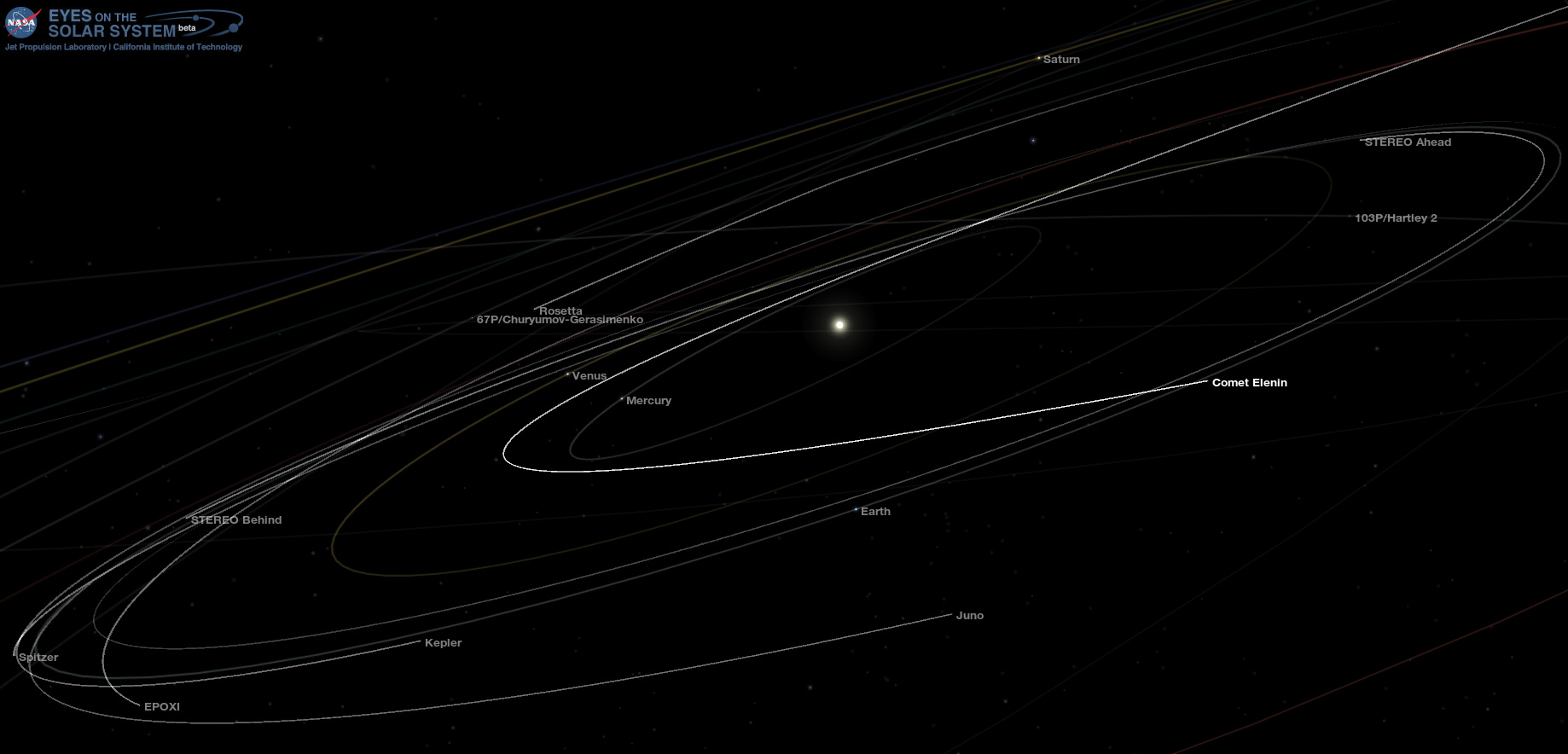Elenin: The Ex-Comet

Elenin (C/2010 X1) was a comet that brushed by Earth safely in October 2011, despite predictions by some that its arrival would trigger tsunamis and earthquakes.
More properly speaking, it was pieces of the comet that flew as close as 22 million miles (35.4 million kilometers) from the planet. Elenin began to break up after a solar storm walloped the comet in August 2011; a close pass by the sun accelerated its disintegration.
Astronomers were baffled as to why the comet, which wasn't expected to be a bright object, attracted so much attention from doomsayers.
The comet had no effect on Earth's gravity, and was never in danger of smacking into the planet before or after it disintegrated.
Discovered by remote control
As is common with comet discoveries, Elenin was first spotted by an amateur. Leonid Elenin, an observer in Lyubertsy, Russia, spotted the comet remotely using the ISON-NM New Mexico observatory.
When he spotted the comet on Dec. 10, 2010, it was still 401 million miles (647 million km) from Earth and quite faint.

While some people may have been hoping for a good show similar to what comets Hale-Bopp and Hyakutake put in the 1990s, as early as August NASA said Elenin would probably be visible in binoculars, at best – if it lived up to predictions.
"This comet may not put on a great show. Just as certainly, it will not cause any disruptions here on Earth. But there is a cause to marvel," stated Don Yeomans, an astronomer with the Near-Earth Object Program Office at NASA's Jet Propulsion Laboratory in Pasadena, Calif.
"This intrepid little traveler will offer astronomers a chance to study a relatively young comet that came here from well beyond our solar system's planetary region. After a short while, it will be headed back out again, and we will not see or hear from Elenin for thousands of years. That's pretty cool."
Broken by the sun
Comets are unpredictable beasts. The conglomerates of icy debris tend to erupt at unpredictable times, making it difficult for astronomers to figure out how bright they will be and if they will even survive the trip toward the inner solar system.
Elenin made predictions more difficult because it was a long-period comet, meaning that it originated from an area at the edge of the solar system. There were no past predictions to consult. These comets come to be in the Oort Cloud, a vast collection of icy bodiesbeyond the orbit of Neptune.
Every so often, a stray gravitational force kicks one of the bodies toward the inner solar system. When it gets closer to the sun, the ice begins to melt and stream away, producing the shape of a comet.
Elenin, at only 2-3 miles (3-5 kilometers) across, wasn't a very robust object to begin with when particles from the sun began to hit it. After a large storm in August pummelled the comet, an amateur captured pictures of the nucleus appearing to fall apart.
On Sept. 10, Elenin made its closest approach to the sun, accelerating its breakup. By the time it was set to pass by Earth in late October, astronomers said the comet was just crumbs of its former self.
"Folks are having trouble finding it, so I think it's probably dead and gone," Yeomans said in an October 11 SPACE.com interview, pointing out that the comet's leftovers wouldn't return to the inner solar system for another 12,000 years.
"Elenin was a second-rate, wimpy little comet that never should have been noted for anything, really," he added. "It was not even a bright one." [Gallery: Comet Elenin in Pictures]
'Interplanetary bogeyman'
Perhaps with 2012 Apocalypse rumors beginning to take hold, some supposed that Comet Elenin could also wreak devastation on the planet.
Rumors ranged from large tides and shifting tectonic plates, to such ideas that Elenin would blot out the sun for three days (impossible due to the small size of the comet and its orbit) or that Elenin was actually a brown dwarf star.
One conspiracy theory said Elenin stood for the acronym "Extinction-Level Event: Nibiru Is Nigh" (or "Near"), referring to a fabled doomsday scenario where a large object – sometimes called Planet X – approaches or collides with Earth.
By the time Elenin disintegrated, NASA press releases on the comet began to take on a tone of frustration with the ongoing doomsday talk.
One press release said the comet was gone and "should be forgotten." The agency pointed out that every time it tried to rebut the rumors, it was accused of hiding the truth. NASA said the comet had been an insignificant event and not the "interplanetary bogeyman" that some people made it out to be.
"Perhaps a little homage to a classic Monty Python dead parrot sketch is in order," stated Yeomans. "Comet Elenin has rung down the curtain and joined the choir invisible. This is an ex-comet."
— Elizabeth Howell, SPACE.com Contributor
Join our Space Forums to keep talking space on the latest missions, night sky and more! And if you have a news tip, correction or comment, let us know at: community@space.com.
Get the Space.com Newsletter
Breaking space news, the latest updates on rocket launches, skywatching events and more!

Elizabeth Howell (she/her), Ph.D., was a staff writer in the spaceflight channel between 2022 and 2024 specializing in Canadian space news. She was contributing writer for Space.com for 10 years from 2012 to 2024. Elizabeth's reporting includes multiple exclusives with the White House, leading world coverage about a lost-and-found space tomato on the International Space Station, witnessing five human spaceflight launches on two continents, flying parabolic, working inside a spacesuit, and participating in a simulated Mars mission. Her latest book, "Why Am I Taller?" (ECW Press, 2022) is co-written with astronaut Dave Williams.










